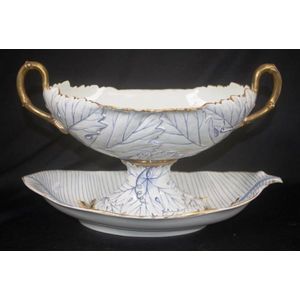Wedgwood Creamware Comport and Stand with Blue Leaf Decoration
You must be a subscriber, and be logged in to view price and dealer details.
Subscribe Now to view actual auction price for this item
When you subscribe, you have the option of setting the currency in which to display prices to $Au, $US, $NZ or Stg.
- Comport - A comport is a type of decorative serving dish or bowl, typically used for desserts, fruits or other sweet treats. The comport is usually made from glass, silver or porcelain, which are materials known for their elegance and durability. They are often beautifully designed and decorated, and can be used as an elegant and decorative centerpiece for a table or dining room. They are also widely used as a decorative piece on the mantelpiece, sideboard, or other areas of the house.
- Creamware - Creamware, also known as "Queens Ware" is the
cream-coloured English earthenware developed by Josiah Wedgwood in the 1760s.
The invention of creamware was the result of experimentation in order to find a
British substitute for imported Chinese porcelain, and the cream colour was
considered a fault at the time. The lightweight fine white earthenware with a
clean rich yellowish proved ideal for tableware
and decorative items during the 18th and 19th centuries and is still produced
today.
Creamware is made from a
mixture of kaolin, feldspar, and ball clay, and is typically glazed before
firing to give it its glossy finish. It was developed by British potters as a
cheaper alternative to porcelain.
At Wedgwood, Royal patronage
boosted sales. In 1765 Queen Charlotte, the consort of King George III placed
an order for a 12 place tea set and allowed Wedgwood to use the name
"Queens Ware" for the line. In 1770 Wedgwood produced a creamware
dinner service of 952 pieces supplied to Catherine II the Great of Russia.
Other potteries such as
Doulton, Neale & Co. and Spode produced smaller quantities of creamware.
Creamware continued to be
made throughout the 19th century and later.
This item has been included into following indexes:
-
Wedgwood (England), item types
- bowls 179
- comports & centrepieces 32
- Creamware / Queens Ware 51
- plates 289
Visually similar items

William IV hallmarked sterling silver baluster partial fluted coffee pot by Richard Pearce and George Burrows, London circa 1830-31, 825 grams

George III sterling silver creamer, hallmarked London, 1775, Thomas shepherd, of of baluster form, s scroll handle, beaded and crimped rim, decorated with garlands and ribbons, on a circular foot, total weight 62grams, height 10.5 cm

A George III silver helmet creamer, mark George Gray overstruck makers mark possibly Peter and Ann Bateman, London 1793

A George III sterling silver helmet shaped cream jug by Crispin Fuller, London 1792, height 16 cm, 110 grams
